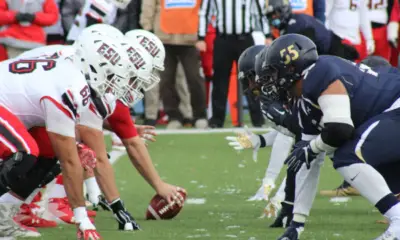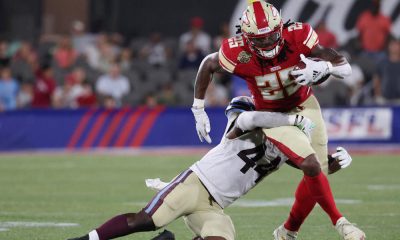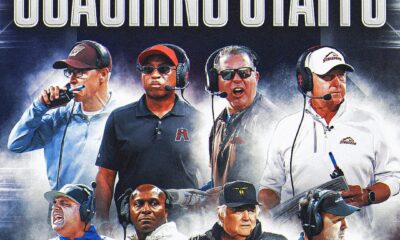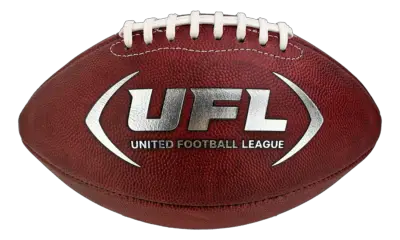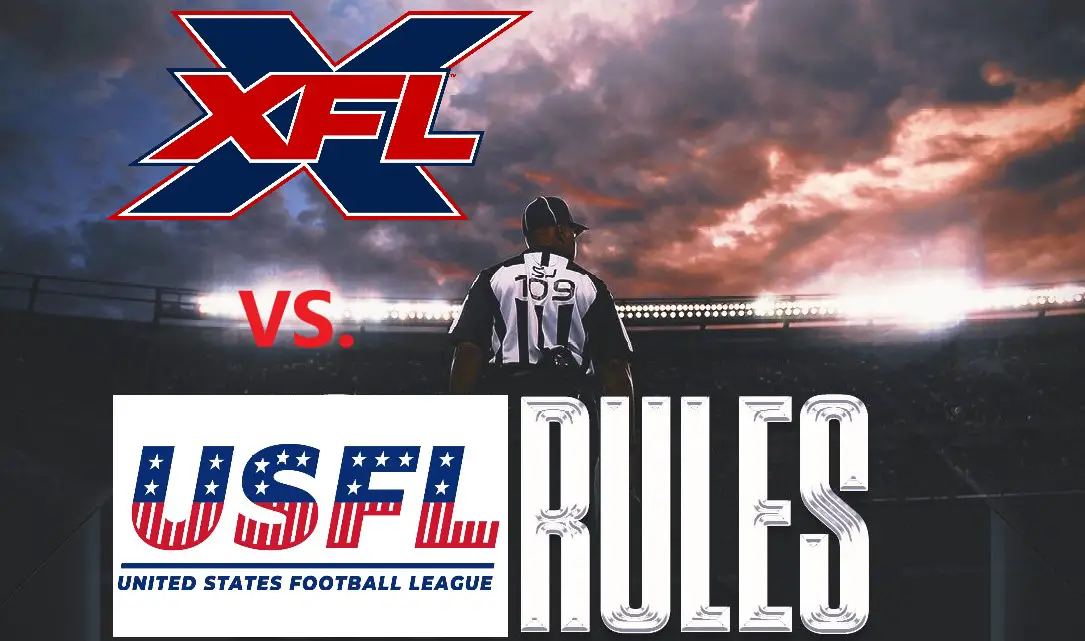
The USFL Rulebook has finally reached our desks after constant online chatter.
The USFL seemingly strove to primarily copy the NFL’s rule methodology based on President of Football Operations Brian Woods’ comments of the guide being “98%” identical to the NFL rule book. However just from glancing at the rulebook this may not be as carbon copy as Woods may have suggested. In fact, it has several similarities to that of the XFL’s 2020 rulebook used in the 2.0 era, which was developed by its founder and creator Sam Schwartzstein. If imitation is indeed the sincerest form of flattery, then the USFL is handing Schwartzstein their biggest compliment.
The XFL was able to separate itself from other league’s rule sets by emphasizing innovation in play mechanics, officiating, technology, and player safety. The USFL seeks to combine the best of what has worked for their predecessors and combine those elements into one cohesive model of pigskin legislation. The time has come to compare the new USFL rule book with that of its contemporaries and predecessors.
Extra Points
One of the consistent themes in the XFL was the deemphasis on kicking as a critical function during plays. The extra point system was emblematic of this as teams were no longer permitted to kick extra points. Instead, upon scoring a touchdown squads could elect to either go for a 1-point conversion from the 2-yard line, a 2-point conversion from the 5-yard line, or a 3-point conversion from the 10-yard line. This allowed teams to not have more scoring options, but also allow a team to potentially tie the game if they were down by nine points.
The USFL has adopted this format in a similar matter, but also created a fusion between the XFL’s system and the NFL’s version. In the USFL teams can choose to go for an extra point attempt from the 15-yard line (NFL), a 2-point attempt from the 2-yard line (NFL and XFL), and a 3-point attempt from the 10-yard line (XFL). This is presents coaches with an opportunity to either stick with traditional methods or roll the dice if they feel strongly about their offensive personnel.
EXTRA POINTS 💪
— USFL (@USFL) March 23, 2022
In the USFL you can go for 1, 2 or 3 points after scoring a touchdown 🏟 pic.twitter.com/vtcmxsmx9H
Instant Replay
The XFL eliminated coaches’ challenges and instead implemented a replay system where replay officials could review questionable rulings and legislate the game. Obvious errors in regards to player safety would also be subject to review. In the last five minutes of the 4th quarter or during overtime officials were permitted to correct egregious errors that significantly impacted the outcome of the match.
The USFL will run all its replays out of its command center in Los Angeles where all decisions will be made one replay crew. Coaches will be granted one challenge to use. The command center will have the authority to overrule any incorrect personal foul calls and determining the accuracy of pass interference calls. This system is more comparable to the NFL’s replay structure than the XFL’s.
Kickoffs
The kickoffs were arguably the most unique aspect of the XFL’s rules set that sought to enhance player safety and create more dynamic returns. The complexity of the XFL’s kickoffs requires the details to be laid out in their entirety. Here’s an excerpt from the XFL’s website:
- “The kicker kicks from the 30-yard line and must kick the ball in the air and in play between the opponent’s 20-yard line and the end zone.
- The coverage team lines up on the return side 35-yard line and the return team lines up on the 30-yard line. Each team must have exactly 3 players outside the hash marks on both sides of the ball and cannot move until the ball is caught by the returner.
- Out of bounds kicks and kicks that fall short of the 20-yard line will result in an illegal procedure penalty, taking the ball all the way out to the kicking team’s 45 yard line.
- Players can move when the ball is touched by the returner or 3 seconds after the ball touches the ground (when the official waves his hand down).
- If the ball is kicked into the end zone and is downed it is a “Major” touchback and the ball is placed at the return side 35-yard line.
- If the ball bounces in bounds and then out of the end zone or is downed in the end zone, the ball is placed at the return side 15-yard line.
- If a player on the return team touches the ball and it goes out of bounds, the ball is spotted where it went out of bounds.”
The USFL kickoff is nowhere near as complex and instead goes for the NFL’s model but moving the kickoff to the 25-yard line of the kicking team. This was presumably created to prevent kickers from booting the ball into the end zone for a touchback. The receiving team must have a minimum of eight players in a zone between their 35 and 45-yard line. After the ball travels 20 yards through the air, only the receiving team may touch the ball.
Timing/Comeback Period
The XFL made adjustments to the final two minutes in each half of the games. During this time plays that end in the field of play resulted in the game clock being stopped until the ball was spotted and 5 seconds had run off the game clock. Incomplete passes and out of bound plays meant the game clock was stopped completely until the ball was snapped. In the USFL the clock will only stop on first downs inside of the last 2 minutes of each half. Each league is attempting to make the final moments of both halves more compelling with extra opportunities being granted to the offenses.
Onside Kicks
The XFL modeled its onside kicks after the NFL’s format by doing a traditional attempt from a team’s own 35-yard line. Like the NFL, the ball also had to travel at least 10 yards before being recovered by the kicking team. Onside kicks had to be announced beforehand to the officials, so surprise onsides were not an option.
The USFL has decided to create more dynamic options by granting squads two distinct choices. Teams may either kick from their own 25-yard line in a traditional attempt or elect for a 4th-and-12 play from their own 33-yard line. This is an option borrow from the AAF rulebook and allows for the choice of either a special teams or offensive conversion.
A lot of risk, but a lot of reward 😏
— USFL (@USFL) March 23, 2022
In the USFL you have another option on top of the onside kick: A 4th & 12 scrimmage play from the 33-yard line 👇 pic.twitter.com/zGprwoSlHD
Overtime
This is where a direct line can be drawn between the XFL and the USFL in regard to rules usage. The overtime system in the XFL was a shootout format where each team had five chances to convert as many 2-point plays as possible. In the event that both teams were tied after five attempts they would go to a sudden-death conversion process. This is the same system in the USFL, but this time with just three chances. Another nod is given to Schwartzstein’s vision.
Rules are HERE 🔥
— USFL (@USFL) March 23, 2022
First up: An Overtime like you've never seen before ⬇️ pic.twitter.com/6aGRsUalGt
Punts
In the XFL gunners had to line up at the line of scrimmage and were not permitted to move laterally until the ball was kicked. The XFL’s rules mostly discouraged teams from punting on a certain part of the field. If the ball was punted out of bounds inside the 35-yard line, went into the opponent’s end zone or out of the end zone, it would be awarded to the receiving team at the 35-yard line. The USFL meanwhile makes a slight tweak by restricting gunners from lining up outside of the numbers or from being double teamed until the ball is kicked.
Penalties
The most significant penalty applications in the XFL have already been mentioned with the kickoffs and punts. The USFL’s primary penalty altering comes with pass interference. Defensive pass interference (DPI) can still be at the spot of the foul, but only up to 15 yards. This is more reminiscent of the NCAA’s DPI rule. Conversely, offensive pass interference and illegal man downfield cannot be assessed if a pass does not cross the line of scrimmage. This is meant to cut down on punishments for the offense unrelated to what is occurring during the play.
Double Forward Pass
Not to sound like a broken record, but once again the USFL has adopted an innovation from the XFL. The ability for offense to attempt two forward passes behind the line of scrimmage was a hallmark of the XFL’s attempt to differentiate itself from other leagues and apparently the USFL’s operational staff agreed.
Offenses will have more options than ever this Spring 🔥
— USFL (@USFL) March 23, 2022
Get ready for two forward passes from behind the line of scrimmage ⬇️ pic.twitter.com/JlpPLrbXLG
Clearly the USFL is attempting to balance the innovation of the XFL’s bold rules book with the NFL’s tried and true traditions. The execution of this rulebook will be in full effect in less than a month when the league kicks off on April 16 from Birmingham, Alabama.






